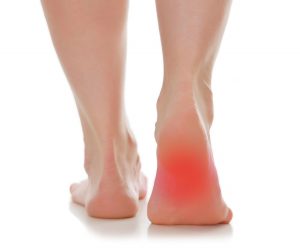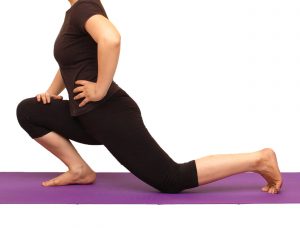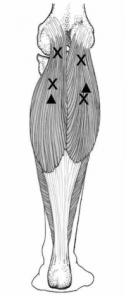
Heel pain is often from plantar fasciitis, a reactive condition of the tendons in the sole of the foot. This is characteristically most painful with the first few steps after getting out of bed, or after prolonged rest, and the pain reduces after walking around a bit. Pulling the toes up towards the top side of the foot and the shin, or pressing around the heel pad of the sole close to the back of the foot (over the bone known as the calcaneus) may reproduce the pain.
Acupuncture is a good treatment option for plantar fasciitis, and the treatment is helped by the use of herbal foot soaks and physical therapy.
Plantar fasciitis often results from the tendons of the sole of the foot being overloaded by poor posture and muscle recruitment. Sitting at a desk all day can shorten the muscles that pull the legs towards the hips and spine, and this can prevent the butt muscles from efficiently moving the legs to drive us forwards as we walk or run, or upwards as we climb stairs or get up from sitting. As a result the calfs and hamstrings do more work than they should, and this overuse can concentrate the tension in the tendons of the sole of the foot.
Notice that I said that this is a reactive condition, rather than an inflammatory one. Chronic tendon pathology that is described as tendinopathy rather than tendonitis does not involve inflammation, but various changes to the tissue as it tries to repair itself and cope with the excessive loads placed on it while it is injured. As part of the recognition that the condition is not an inflammatory one, the preferred name for it is plantar fasciosis.(1) As there is no inflammation, it makes little sense to use anti-inflammatory medications such as ibuprofen. Sometimes they can provide short-term pain relief, but there is no evidence that they are of any long-term benefit.(2)
Acupuncture can relieve the pain of plantar fasciitis and promote recovery, and reduce the tension in the leg muscles that are creating the problem. Not only have there been clinical trials that show this, (3, 4) but many health practitioners who aren’t acupuncturists use our techniques because they work. Betterness Acupuncture & Herbs also uses a mixture of herbs to soak the affected foot that relieves pain and helps heal the tendons. The combination of acupuncture and herbal therapy was evaluated positively in a study by a Chinese hospital.(5)
There are also ways that you can work on plantar fasciitis yourself, although of course it would be best if you consulted a professional to see if these are appropriate for your particular case.
Local stretching used to be recommended for tendon injuries, but current thinking is that it may not help, instead targeted resistance training that helps restore the proper structure of the tendons to relieve pain and speed recovery is used.(6) For a while it was thought that letting muscle and tendon lengthen under load (eccentric resistance) was most effective, but the tendency now is to recommend isometric training in which the load is maintained as long as 30 seconds.
A good initial exercise would use a rolled towel to flex the toes towards the top of the foot, and you should then try to curl the toes into the towel and hold it for 30 seconds, like this. Then do the other side, and repeat the cycle 3-5 times.
Progression to muscle chain exercise using the calf depends on how bad the pain in the sole is, and should be individually assessed, but isometric strengthening as in this video is usually ok. Hold the position at the top for 30 seconds, then do the other side. Again 3-5 repetitions a side should be done. The exercise itself could be painful, but the pain shouldn’t be worse afterwards and there may even be some relief. If it’s worse the next day back off.
Stretching the fascia doesn’t help, but it does make sense to stretch the muscles that may be contributing to the poor posture and movement patterns that are responsible for the plantar fasciitis, and the muscles that are tight because of this.
 Hip flexors can be a bugger to isolate and stretch, as they run deep and connect to both the hip and spine. Many people try this stretch but end up letting their hip roll forwards so that the hip flexors are not stretched at all, as in the picture to the left.
Hip flexors can be a bugger to isolate and stretch, as they run deep and connect to both the hip and spine. Many people try this stretch but end up letting their hip roll forwards so that the hip flexors are not stretched at all, as in the picture to the left.
Perhaps the best way of stretching them is part with something like a cobra pose, but again this is often done is a way that doesn’t work. The emphasis has to be on keeping the pelvis on the ground rather than trying to push the shoulders as far as possible from the floor. Sometimes it seems that the more attractive the demonstrator is, and the more scenic the location, the less likely the posture is to stretch the hip flexors. Most people don’t have the flexibility to keep the pelvis on the floor with straight arms, so do it like the picture on the left, rather than the right. And spread your legs apart a little rather than keeping them together and you should feel a stretch along the inside of your thighs.


There are also manual release techniques that are best taught by professionals.
 If tight hip flexors are the problem then the hamstrings will be over-extended already, so they should not be stretched, but the tension in the hamstrings and calfs can be eased by foam rolling. It is also good to use massage ball on the calf and the sole of the foot. There is an acupuncture point between the two heads of the most superior calf muscle, this can be a good place to press with the ball to relax the muscle and encourage recovery and healing. You can also work on the motor and trigger points shown in the diagram on the left.
If tight hip flexors are the problem then the hamstrings will be over-extended already, so they should not be stretched, but the tension in the hamstrings and calfs can be eased by foam rolling. It is also good to use massage ball on the calf and the sole of the foot. There is an acupuncture point between the two heads of the most superior calf muscle, this can be a good place to press with the ball to relax the muscle and encourage recovery and healing. You can also work on the motor and trigger points shown in the diagram on the left.
- Rees JD, Maffulli N, Cook J. “Management of Tendinopathy” Am J Sports Med 37(9):1855-67 · March 2009
- Childress MA, Beutler A. “Management of Chronic Tendon Injuries” Am Fam Physician. 2013 Apr 1;87(7):486-490
- Shi Ping Zhang, Tsui-Pik Yip, and Qiu-Shi Li “Acupuncture Treatment for Plantar Fasciitis: A Randomized Controlled Trial with Six Months Follow-Up” Evidence-Based Complementary and Alternative Medicine Volume 2011, Article ID 154108. Retrieved 7/7/18
- Wipoo Kumnerdee, Nitsara Pattapong “Efficacy of Electro-Acupuncture in Chronic Plantar Fasciitis:A Randomized Controlled Trial” The American Journal of Chinese Medicine, Vol. 40, No. 6, 1167–1176 2014. Retrieved 7/7/18
- Healthcare Medicine Institute “Acupuncture Plantar Fasciitis Relief Confirmed” November 27 2017. Retrieved 7/7/18
- Rathleff MS, Molgaard CM, Fredberg U, Kaaland S, Andersen KB, Jensen TT, Aaskov S, Oleson JL “High-load strength training improves outcome in patients with plantar fasciiitis: A randomized controlled trial with 12-month follow-up” Scand J Med Sci 2014